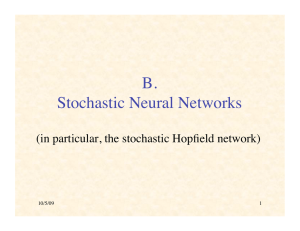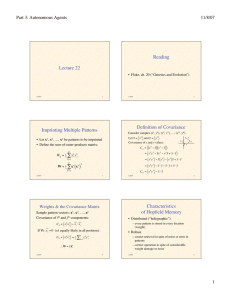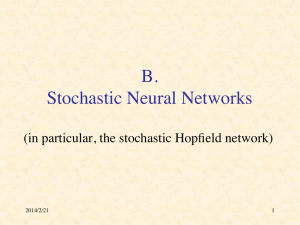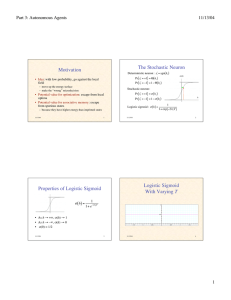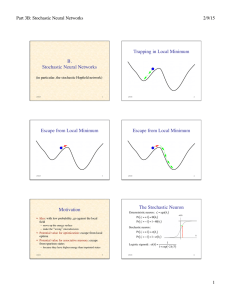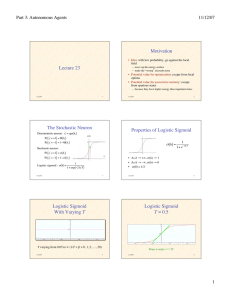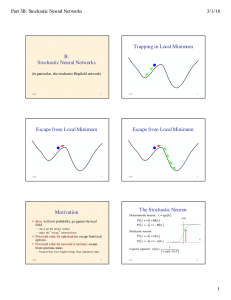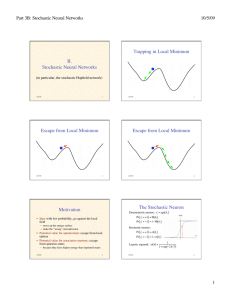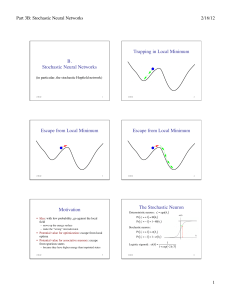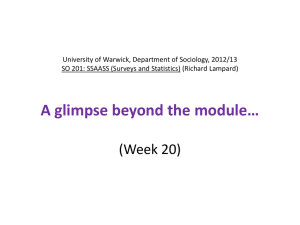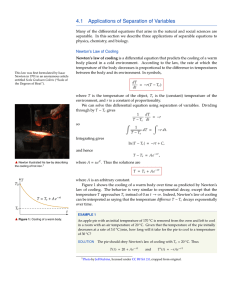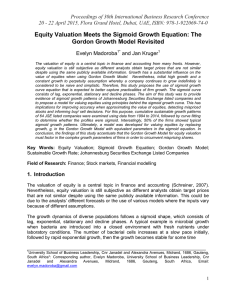Capacity of Hopfield Memory • Depends on the patterns imprinted p n
advertisement
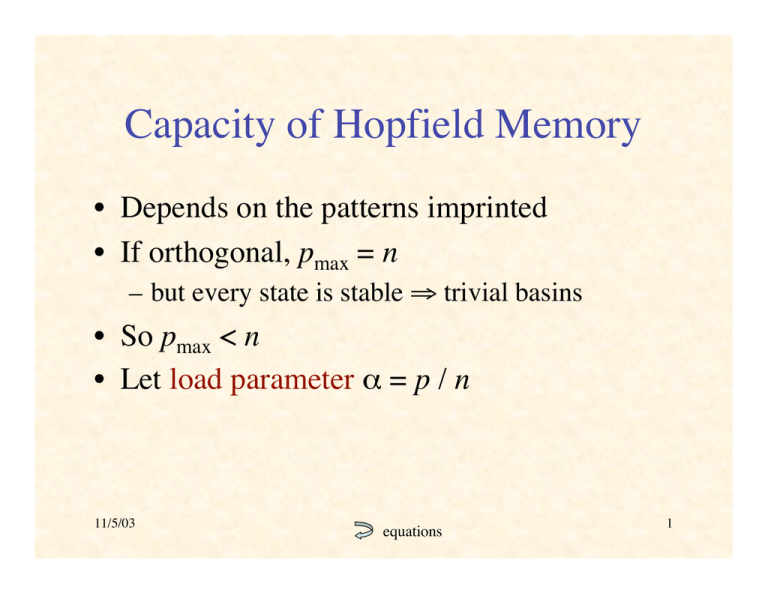
Capacity of Hopfield Memory
• Depends on the patterns imprinted
• If orthogonal, pmax = n
– but every state is stable fi trivial basins
• So pmax < n
• Let load parameter a = p / n
11/5/03
equations
1
Single Bit Stability Analysis
• For simplicity, suppose xk are random
• Then xk ⋅ xm are sums of n random ±1
ß
ß
ß
ß
binomial distribution ≈ Gaussian
in range –n, …, +n
with mean m = 0
and variance s2 = n
• Probability sum > t:
È
˘
Ê
ˆ
t
1
˜˙
2 Í1- erf Á
Ë 2n ¯˚
Î
[See “Review of Gaussian (Normal) Distributions” on course website]
11/5/03
2
†
Approximation of Probability
Let crosstalk Cim =
1
n
k
k
m
x
x
⋅
x
 i(
)
k≠m
We want Pr{Cim > 1} = Pr{nCim > n}
p
†
†
†
†
†
n
Note : nCim = Â Â x ik x kj x mj
k=1 j=1
k≠m
A sum of n( p -1) ª np random ± 1
Variance s 2 = np
11/5/03
3
Probability of Bit Instability
È
˘
Ê
ˆ
n
Pr{nCim > n} = 12 Í1- erf Á
˜˙
ÍÎ
Ë 2np ¯˙˚
=
1
2
[1- erf (
n 2p
)]
†
11/5/03 (fig. from Hertz & al. Intr. Theory Neur. Comp.)
4
Tabulated Probability of
Single-Bit Instability
a
Perror
11/5/03
0.1%
0.105
0.36%
0.138
1%
0.185
5%
0.37
10%
0.61
(table from Hertz & al. Intr. Theory Neur. Comp.)
5
Spurious Attractors
• Mixture states:
–
–
–
–
sums or differences of odd numbers of retrieval states
number increases combinatorially with p
shallower, smaller basins
basins of mixtures swamp basins of retrieval states fi
overload
– useful as combinatorial generalizations?
– self-coupling generates spurious attractors
• Spin-glass states:
– not correlated with any finite number of imprinted
patterns
– occur beyond overload because weights effectively
random
11/5/03
6
Basins of Mixture States
x
k1
x
x
†
†
11/5/03
k3
mix
† k2
x
x imix = sgn( x ik1 + x ik2 + x ik3 )
7
Fraction of Unstable Imprints
(n = 100)
11/5/03
(fig from Bar-Yam)
8
Number of Stable Imprints
(n = 100)
11/5/03
(fig from Bar-Yam)
9
Number of Imprints with Basins
of Indicated Size (n = 100)
11/5/03
(fig from Bar-Yam)
10
Summary of Capacity Results
• Absolute limit: pmax < acn = 0.138 n
• If a small number of errors in each pattern
permitted: pmax µ n
• If all or most patterns must be recalled
perfectly: pmax µ n / log n
• Recall: all this analysis is based on random
patterns
• Unrealistic, but sometimes can be arranged
11/5/03
11
Stochastic Neural Networks
(in particular, the stochastic Hopfield network)
11/5/03
12
Trapping in Local Minimum
11/5/03
13
Escape from Local Minimum
11/5/03
14
Escape from Local Minimum
11/5/03
15
Motivation
• Idea: with low probability, go against the local
field
– move up the energy surface
– make the “wrong” microdecision
• Potential value for optimization: escape from local
optima
• Potential value for associative memory: escape
from spurious states
– because they have higher energy than imprinted states
11/5/03
16
The Stochastic Neuron
Deterministic neuron : s¢i = sgn( hi )
Pr{s¢i = +1} = Q( hi )
Pr{s¢i = -1} = 1- Q( hi )
Stochastic neuron :
Pr{s¢i = +1} = s ( hi )
†
†
†
s(h)
h
Pr{s¢i = -1} = 1- s ( hi )
1
Logistic sigmoid : s (h ) =
1+ exp(-2 h T )
11/5/03
17
Properties of Logistic Sigmoid
1
s (h) =
1+ e-2h T
• As h Æ +•, s(h) Æ 1
• As h Æ –•, s(h)†Æ 0
• s(0) = 1/2
11/5/03
18
Logistic Sigmoid
With Varying T
11/5/03
19
Logistic Sigmoid
T = 0.5
Slope at origin = 1 / 2T
11/5/03
20
Logistic Sigmoid
T = 0.01
11/5/03
21
Logistic Sigmoid
T = 0.1
11/5/03
22
Logistic Sigmoid
T=1
11/5/03
23
Logistic Sigmoid
T = 10
11/5/03
24
Logistic Sigmoid
T = 100
11/5/03
25
